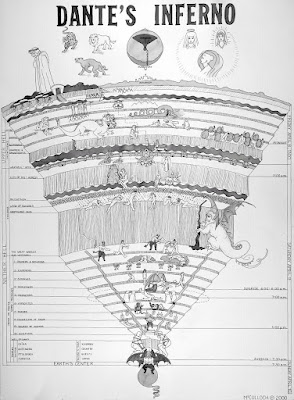
One would suppose that, to a demon that has taken up residence in the corpse of a recently deceased man or woman and has a penchant both for sucking the blood of the living and transforming as many of them into fellow vampires as possible, a clove of garlic would be the least of its concerns. Such is not the case. To vampires, as such bloodsuckers are more commonly known--to devotees of horror, if no one else--a bit of garlic is itself a horror, ranking with the cross of Christ or holy water, to be avoided at all costs. Sure, garlic, after it’s eaten, can be pretty funky, but, then again, so can a body that’s been buried for a few days, especially when, as during the days of Dracula, the deceased wasn’t extended the courtesy of having been embalmed first. Nevertheless, it seems that it was the vampire’s fear of the stench that led to garlic’s use as a means among the living to ward off the unwelcome advances of the undead. According to “Garlic and Vampires”:
Garlic has been used in Romania for centuries to ward off evil. In Romania, garlic is a weapon of choice against vampires. Romanians used to make certain that they ate some garlic every day for their personal protection. . . . They also smeared garlic on the windows. . . [and the] doors of their houses, on the gates to their farmyards, and even on the horns of their cattle. They believed that the undead had a great fear of garlic. . . . The stuff tastes divine but smells awful! In Romania if a corpse was thought to be in danger of becoming a vampire, one of the most common [means of] protection was stuffing some pieces of garlic into the orifices of the corpse, especially the mouth. This was done in order to prevent evil spirits from entering the dead body. . . . Another interesting vampire practice is smearing the corpse with a mixture of oil, fat, incense, gunpowder and--of course--garlic. That was probably a pretty good embalming method.
Garlic was also used, according to “Vampires and Werewolves,” as a means of identifying suspected vampires:
People would hang it outside their doorways to keep evil spirits from entering their homes. The ancient societies got a little carried away with garlic[,] condemning anyone who had an aversion to garlic as a vampire. Garlic was also passed out during church ceremonies so that church official could be sure that no evil spirits were attending.
For demon-possessed cadavers, vampires are, in many ways, a rather timid lot, fearing not only garlic but also sunlight, fire, crucifixes, holy water, and mirrors.
“Vampires and Werewolves” points out that vampires’ alleged fear of ultraviolet radiation is a recent addition to the lore concerning these creatures of the night, as is the idea itself that vampires, like werewolves, are necessarily nocturnal:
It's believed that sunlight will destroy vampires. It burns and scares [sic; no doubt, the writer means “scars“] their flesh. If they stay in the light long enough it will burn them completely to ashes. This is not a traditional belief of early cultures. This belief that sunlight kills vampires caught on less than sixty years ago in pop culture and movies and has since become a standard way of destroying a vampire. In traditional times vampires could come out in the sunlight without fear of being harmed by the light itself. However, their powers would be severely weakened in the daytime hours so most vampires probably wouldn't risk being exposed in the day. Smart vampires would stay hidden and sleep until nightfall when they would have all their supernatural powers at their disposal.

It seems that vampires fear the Roman Catholic, rather than the Protestant, idea of God, for they are frightened by the crucifix, not the cross--but only if, as humans, they were God-fearing members of the Christian community; crucifixes didn’t faze Buddhist, Jewish, or Muslim vampires, as “Vampires and Werewolves” makes clear:
A crucifix, not a cross! There is a difference. A crucifix has the likeness of Jesus Christ on it while the cross is just a cross. The power of the crucifix comes from the Christian religion and Jesus Christ's ability to combat and force out evil. Vampires are considered to be demonic agents. The crucifix will only have power over evil if you believe in its power. If you don't believe in the power of the Christian faith then the crucifix will have little use.
It’s pretty obvious as to why vampires fear fire. It burns. Apparently, they fear holy water for the same reason; blessed by a clergyman, it has the same effect upon vampire flesh as acid has upon human skin. As “Vampires and Werewolves” observes, wine can have the same effect as holy water upon vampire epidermises, since wine symbolizes Christ’s blood.
If sunlight, fire, crucifixes, holy water, or mirrors happen to be unavailable, one can slow down a vampire by throwing seeds at it or a rope tied with a lot of knots, preferably in a variety of styles:
Vampires are said to have personality defects that most of us regular mortals would consider odd or even crazy. Vampires are known to have Obsessive-Compulsive Disorder (OCD). OCD is a neurobiological disorder where the affected have recurrent, intrusive thoughts, impulses, and obsessions of repetitive behaviors and mental acts.
Common symptoms of vampire OCD include bizarre checking and counting rituals. For example, a traditional method of escaping from a vampire was to throw down a handful of seeds. The vampire is powerless against its obsession to stop, pick up and count every single seed that was thrown down before doing anything else. An ancient method of stopping a vampire involved filling up its coffin with seeds. The vampire would never be able to escape from it's own impulses [to]. . . check and [count]
. . . the seeds.Vampires also have [to] . . . [untie] every single knot that they come across. If you were to tie one thousand knots on one thousand strings a vampire would have to stop and untie all one thousand knots. It's sounds crazy to many people, but OCD is a real disorder that affects millions of people and vampires all over the world (“Vampires and Werewolves”).
Although authorities disagree, some claim that vampires also fear looking-glasses, because of a phobic dread of mirrors. As “Holiday Insights: Halloween Vampires” observes, “the phobia is known as eisoptrophobia.” Perhaps it springs from the fact that vampires have no reflections and they would give themselves away if they stood before a mirror.

Since the protagonist (or any other character) in a horror story might be accosted by a vampire, a werewolf, or some other sort of monster at any time, it is better to be safe than sorry. A little research could save one’s life, as Rupert Giles, mentor to Buffy the Vampire Slayer, often reminded his protégé, albeit to little or no avail (Buffy was killed--three times--after all.)
Most of us know that werewolves can be killed by a silver bullet, so it’s doubtful that the Lone Ranger and his trusty sidekick Tonto had much to fear from wolfmen. Perhaps that’s the real reason that the Indian brave followed the masked man around; maybe the Wild West was wilder than we realize, with hirsute werefolk running around the plains and prairies. With regard to werewolves, an ounce of prevention is worth a pound of cure, to be sure, and, fortunately, as “Vampires and Werewolves” points out, there are a number of signs by which one can identify these beastly beasties, including “pale skin,” “excessive thirst,” “howling until dawn,” “obsession with walking in cemeteries,” “excessive hair,” “unpleasant odors,” “skin that gradually changes color,” and “the mark of the werewolf,” which is “the pentagram, a five[-]pointed star and magical symbol. . . found somewhere on the werewolf. . . . usually found on the chest or hand (palm) of the werewolf.”
We’ve given you the dirt, so to speak, on vampires and werewolves. There are many other otherworldly, paranormal, and supernatural monsters abroad in horror fiction, many as bad, of not worse, than one’s mother-in-law, as hard as that may be to believe, so a textbook or two in the subject of how to survive these threats might be a good investment. One such book is How To Survive A Horror Movie: All the Skills to Dodge the Kills, which offers such tips as:
1. Don’t consume recreational drugs.
2. Never say “I’ll be right back”; if you do, you won’t.
3. Turn on the lights upon entering a room.
4. Avoid reciting spells concerning the invocation or summoning of demons.
5. Never go into an attic or a basement, especially alone.
6. Check your back seat before getting into your automobile.
7. Be prepared to kill your cat.
8. Flee from mad serial killers (or any other kind) by exiting the house, not by dashing upstairs or into the interior of the house.
9. Never separate; the monster knows the strategy of divide and conquer.
10. The monster is never dead, not even after it’s been decapitated, crushed, shot, stabbed, and strangled, so don’t check to see if it is.











 In case you were wondering (you probably weren’t), my own takes are that Summer of Night is well worth reading, The Terror is nigh unreadable, and Desperation is one of King’s best books ever. The reasons for these assessments, in nutshells, are Summer of Night's realistic and believable recreation of America as it was for many during the late 1950’s and early 1960’s, sympathetic characters, effective chills and thrills, and an interesting back story concerning the history of the bell that focuses and draws the ancient evil to the novel’s unsuspecting and enchanting town; The Terror's needless detail about the most minute aspects of everything nautical and historical, characters who are difficult to get to know, much less to care about, and a lack of overt action during most of the story; and Desperation's sympathetic and believable characters (always a strength in King’s fiction), an interesting antagonist, high stakes, the religious and moral dimensions, and, of course, the chills and thrills. Concerning Desperation, it was difficult to find any negative comments among horror fans.
In case you were wondering (you probably weren’t), my own takes are that Summer of Night is well worth reading, The Terror is nigh unreadable, and Desperation is one of King’s best books ever. The reasons for these assessments, in nutshells, are Summer of Night's realistic and believable recreation of America as it was for many during the late 1950’s and early 1960’s, sympathetic characters, effective chills and thrills, and an interesting back story concerning the history of the bell that focuses and draws the ancient evil to the novel’s unsuspecting and enchanting town; The Terror's needless detail about the most minute aspects of everything nautical and historical, characters who are difficult to get to know, much less to care about, and a lack of overt action during most of the story; and Desperation's sympathetic and believable characters (always a strength in King’s fiction), an interesting antagonist, high stakes, the religious and moral dimensions, and, of course, the chills and thrills. Concerning Desperation, it was difficult to find any negative comments among horror fans.



























